
This of course is one of the icons of vintage audio – the Pioneer SX-1980 receiver. This receiver is highly sought after today and prices can reach well into the thousands of dollars for a well maintained unit. Some will argue that other Pioneer models sound better, but the fact still remains that the monster SX-1980 was the king of the audio mountain in it’s day. It was the Pioneer’s flagship model and one of the most powerful and sought-after receivers of its time.
The SX-1980 was designed as a high-end receiver that combined powerful amplification with advanced features and high-quality components. It was built to handle large speaker systems and deliver clean, distortion-free sound at high volumes.
The development of the SX-1980 began in the mid-1970s, when Pioneer engineers set out to design a receiver that would surpass their previous flagship model, the SX-1250. The new receiver was to have a power output of 270 watts per channel, which would make it the most powerful receiver on the market at the time. In fact, Pioneer called the SX-1980 a “Super Receiver”.
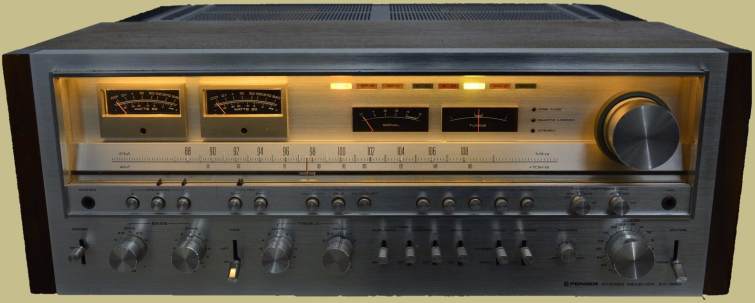
The SX-1980 was introduced in 1978 and quickly gained a reputation for its power and sound quality and was praised by audiophiles. It represents a significant milestone in the development of high-end audio equipment. Its power, performance, and innovative design helped to set a new standard for what consumers could expect from home audio systems and established Pioneer as a leading brand in the high-end audio market.
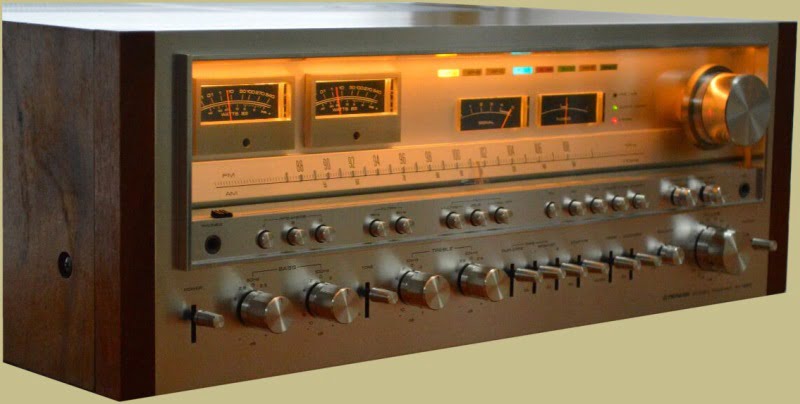
Today it is considered an iconic piece of audio equipment due to several key factors:
Power and Performance: The SX-1980 was one of the most powerful receivers of its time, with a power output of 270 watts per channel. It was designed to drive large speakers and deliver clean, distortion-free sound even at high volumes. This level of power and performance was unprecedented in consumer audio equipment at the time and helped set a new standard for what was possible in home audio systems.
Design and Innovation: The development of the SX-1980 involved significant advances in amplifier circuitry, power supply design, and heat management. The use of discrete transistors, a massive toroidal transformer, and large heat sinks were all innovative features that contributed to the receiver’s exceptional performance.
Commercial Success: Despite its high price tag, the SX-1980 was a commercial success and became a status symbol for audiophiles and music enthusiasts. Its popularity helped to establish Pioneer as a leading brand in the high-end audio market and set a new benchmark for what consumers could expect from home audio equipment.
Legacy and collectibility: The SX-1980 has remained highly desirable among collectors and enthusiasts, and its reputation has only grown in the decades since its release. Its enduring popularity is a testament to its exceptional performance and its significance in the history of audio technology.
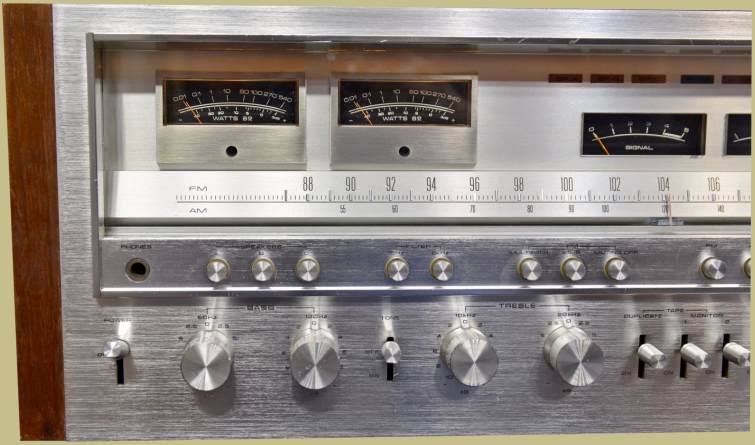
The SX-1980 features a beautiful walnut veneer wood cabinet and brushed aluminum face plate that was designed to withstand wear and tear. It has the classic late 1970’s Pioneer look that so many seek out today. The numerous controls, dual bass and treble controls, filter controls, loudness, and a range of other controls, are well laid out and the beveled knobs give it a touch of class.
The twin tuning meters are for AM/FM signal strength and center tuning for FM. The user can manually position moveable dial markers to mark their favorite dial locations. The SX-1980 has two controls for both Bass and Treble.
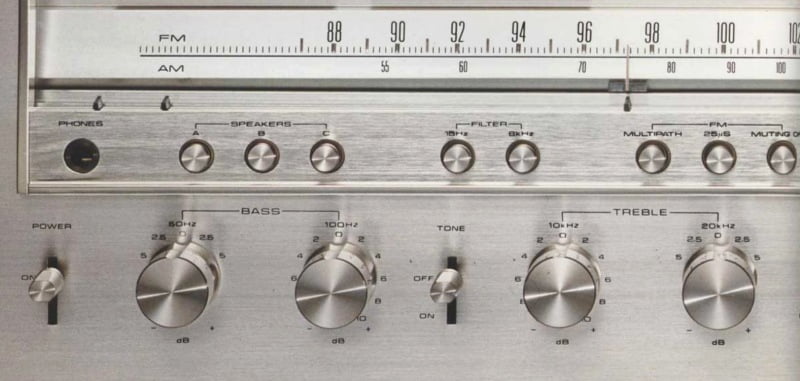
The FM tuner is excellent. It’s a Quartz sampling lock FM tuning system with a touch sensor tuning knob. Notice the three LED indicators to the left of the tuning knob? Turn the tuning knob until the Fine Tune indicator comes on. This means you’re within +/- 8kHz of an FM station. If it’s in stereo the Stereo indicator will come on. Let go of the knob and the green Locked LED will light up indicating that the station is quartz locked.
The FM circuitry utilizes a 5 gang variable capacitor (tuner), and a 2-stage RF amp. These maximize sensitivity and minimize interference.
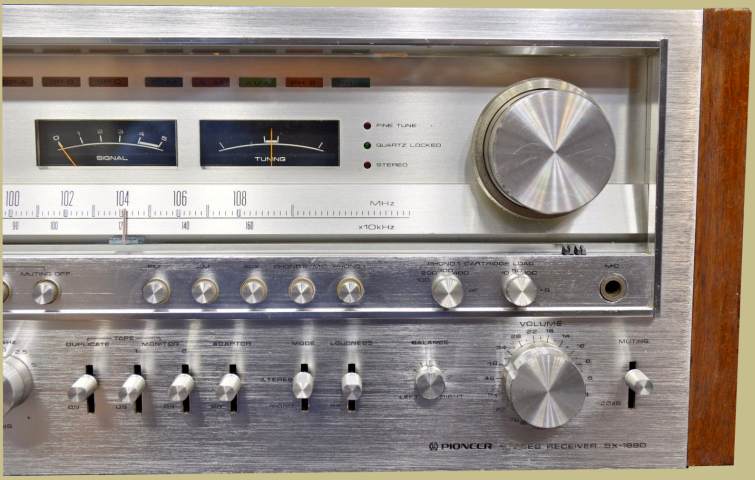
There are source buttons for FM, AM, AUX, Phono2, and Phono 1. It even has controls for Phono cartridge load.
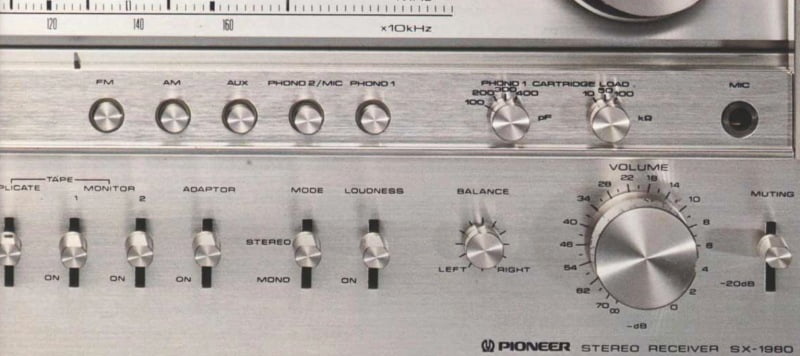
The SX-1980 isn’t called a monster receiver for nothing as it weighs in at 78 pounds. It’s suggested retail price in 1978 was $1295.00 – a very large sum back in those days.
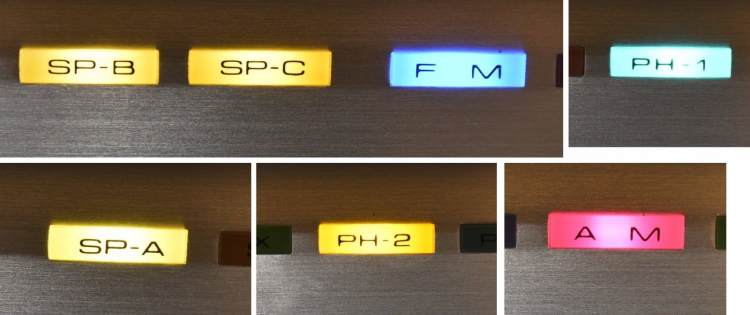
Total harmonic distortion is rated at 0.03% which is extremely low for a power output that high.
Inside the Pioneer SX-1980 you’ll find some advanced features and high-quality components such as:
Amplification circuitry and power output: The SX-1980 was designed with DC power amplification circuitry that uses 6 high quality power transistors per channel.
Toroidal transformer: The toroidal transformer has many advantages over other transformer designs. For one, toroidal transformers produce less electromagnetic interference (EMI) than traditional transformers, which can result in cleaner sound. They are also more efficient, as the windings are closer to the core, reducing the distance that the magnetic field must travel. Toroidal transformers are also more compact than other transformer designs, making them a popular choice for high-end audio equipment. The SX-1980 receiver features a massive (22 pound) toroidal transformer that provides a stable power supply and reduces noise and interference. It was comprised of a round core made of laminated steel and has separate windings for each channel.
Power supply: The toroidal transformer is complemented by a large power supply that is designed to handle heavy loads and ensure consistent performance. It features a large capacitor bank (22,000uf filter capacitors) that helps to smooth out the power supply and reduce noise and interference. The power supply also has multiple voltage regulators that help to ensure a stable and consistent output voltage. The use of a high-quality power supply is critical for the performance of audio equipment, particularly in high-end systems like the SX-1980. A stable and clean power supply can help to reduce distortion, noise, and interference, resulting in a cleaner and more detailed sound.
Heat sinks and cooling system: The SX-1980 was designed with large aluminum heat sinks that were integrated into the chassis of the receiver. These heat sinks were essential for dissipating the heat generated by the amplification circuitry and preventing overheating.
Power protection circuit: Pioneer employed an integrated circuit, PA-3004, in the power protection section to ensure constant power stability and prevent on/off switching noise. There is even a Surge Killer Circuit designed to prevent surge currents from the transformer from causing damage to the transistors or connected speakers.
Build quality and materials: The receiver was built with high-quality components, including premium capacitors, resistors, and transistors. The chassis was made of heavy-duty steel.
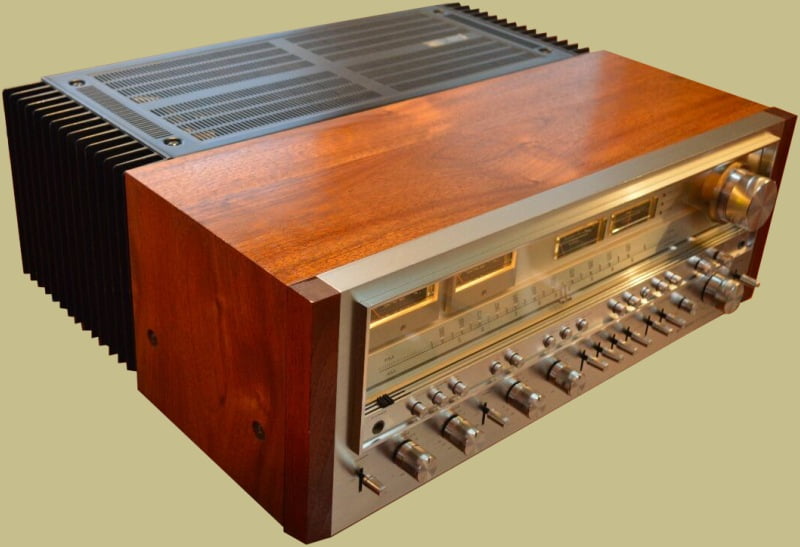
The SX-1980 is compatible with a wide range of speakers, making it a versatile component that can be used in a variety of audio systems. Here are some details about its compatibility with different types of speakers:
Impedance: The SX-1980 is compatible with speakers that have an impedance of 4 to 16 ohms. This covers most types of speakers, from bookshelf speakers to large floor-standing models.
Power handling: The SX-1980 delivers a power output of 270 watts per channel, which makes it suitable for driving even the most power-hungry speakers. It is important to note, however, that not all speakers are designed to handle this level of power. It is important to match the power output of the receiver to the power handling capabilities of the speakers to ensure optimal performance and avoid damage to the speakers.
Speaker connections: The SX-1980 has speaker terminals for three sets of speakers.
Tone controls: The SX-1980 has a range of tone controls, including dual bass and treble controls. These controls allow users to fine-tune the sound of their speakers to their preferences and to compensate for any deficiencies in the speaker’s frequency response.
The compatibility of the SX-1980 with a wide range of speakers is one of the factors that contributed to its popularity and enduring appeal among audiophiles and music enthusiasts.

Look at those heat sinks! They weren’t just for show either. They are made of aluminum and designed to dissipate the heat generated by the amplifier circuitry. The huge fins, which are not covered by the wood case, increase the surface area available for heat dissipation, allowing for efficient cooling of the amplifier modules.
The SX-1980 does have some weaknesses. First and foremost is that some of the parts are basically unobtainable now. The transformer is very difficult to find as are the output transistors. Available parts are usually obtained from donor units and are very expensive.
The unit also tends to run hot which can be disadvantageous for electronic circuitry. The regulated power supply board is mounted on the bottom of the chassis, which doesn’t really allow for good ventilation. Some of the transistors on that board can get very hot. Some owners have been known to mount small fans to the bottom of the unit to increase air circulation.
There are those that feel the SX-1980 is less “musical” than say the SX-1250 o SX-1280. And, many feel that it is over priced today given it’s performance. Of course, it isn’t always about performance. Its rarity and iconic stature and a substantial amount to its current price.
Specifications:
- Tuning range: FM, MW
- Power output: 270 watts per channel into 8Ω (stereo)
- Frequency response: 5Hz to 80kHz
- Total harmonic distortion: 0.03%
- Damping factor: 40
- Input sensitivity: 7.5mV (mic), 2.5mV (MM), 150mV (line)
- Signal to noise ratio: 87dB (MM), 100dB (line)
- Output: 150mV (line), 2V (Pre out)
- Semiconductors: 12 x FET, 11 x IC, 130 x transistors, 84 x diodes
- Dimensions: 560 x 211 x 497mm
- Weight: 35.4kg
- Accessories: FM T-type antenna

The SX-1980 featured a variety of input options, including 2 phono inputs, 2 tape inputs, and an auxiliary input. It also has connectors for three sets of speakers.

Pricing:
5-27-2011 – An SX-1980 sold for $3,250. It had just been serviced and worked perfectly. It was also in very good cosmetic condition and had the original box which always adds some value.
6-5-2011 – SX-1980 sold for $1,760. It was in pretty good cosmetic shape but did have a couple bulbs burned out. Still, a pretty good price for the buyer.
3-25-2017 – Fully restored SX-1980 sold for $5000.00 on March 25, 2017.
3-2017 – Four SX-1980 sales at the beginning of 2017 for $2900.00, $2977.00, $3150.00 and $3500.00.
1-3-2019 – One sold for $5098. Also sales of $3999, $4051, $4499 and $4700.
Here are some sales from November, 2022:


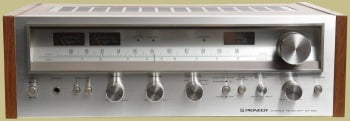
My Dad bought a really nice Pioneer tuner in 1977-78. The face looked just like the 1980 but the top and back looked like the SX780. He gave it away about 10 years ago. Sadly he passed away a few years ago and my Mom wants to know who he gave it to. Anyway, can you tell me was there a unit that one the front looked like the SX 1980 with all the little push buttons? I know for a fact that the top and back did NOT look like the 1980 but the 780. Thanks very much.
The closest I can think of would be the sx-1080, sx-980, sx-950 or sx-1050. The sx-1980, sx-1250, sx-1280 etc have the black metal heat sinks on the side of the case which gave them a different look. The sx-1050 and down did not have that and had full wood panels along the sides with a metal grill on top. The SX-1080 would probably match your description the closest.
I actually have a 780 receiver that I bought in 1978. Although this text would tell you then it’s a 40 W Per channel receiver, I have tested it up to a 120 W per channel, The same goes for the 1980 receiver I have heard it was tested to Well Above 400 W per channel. There is no push buttons on the front of the 780 receiver it is all dials and levers And does not have the big heat sink That the 1980 receiver has.
Not true. The SX-780 absolutely has push buttons. Not as many as larger units, but it does have push buttons. My source… I’m staring at my SX-780 as I type this.
The SX-xx50 series, and SX-xx80 series all had a silver face with the same style of buttons and switches. The bigger the receiver, the more controls it had. Your dads receiver is most likely one these 4 units: SX-680, SX-780, SX-880, or, SX-980.
I purchased my 2nd SX-1980 in Feb. 2010.A few days after receiving it,it wouldn’t power up.So I finally shipped it to a very good repairman in Tx.It is due to arrive back the first or second week in Nov. 2011 fully restored.It’s gonna be so great to get my MONSTER back kicking butts.I sold my first one in 2009 and have regretted it since.This one will be a keeper for good.Mine was manufactured in 1980 with the serial # starting with a “Z”.They sure don’t make ’em like the SX-1980 any more.The pix of the SX-1980 on this page with the blue table cloth was taken on my kitchen table by me when I listed it on eBay in 2009.Others can criticize the SX-1980 all they want.But this MONSTER just can’t be beat.I wouldn’t want nothing else.Why settle for hamburger when I already have steak.
Wow, nice! The SX-1980 is definitely one of the holy grails of vintage receivers. I do hear some criticism about the SX-1980 mainly because of the transformer but when they are functioning properly there isn’t much, if anything, out there that is better. I’ve never owned one but hope to sometime in the future. Every collector should own an SX-1980 at least once in their lifetime.
I have one for sale everything works but the cord that works tuner broke it still jams like no other if instead hit me up you will be surprised what I’m asking
Ok I’ll ask, how much are you asking for your pioneer sx 1980 with the broken tuner cord? thanks
Jay_gats2000@yahoo.com
How much?
How much send some pictures of the sx-1980 please
Hello I have a serviced Pioneer SX-1980 for sale. Please reply with a contact # or email I can text pics / more info to. I am in NY USA. Thank you Stephen
Hi Still sx1980 available for sale?
Thanks
I Have a SX1980 for sale if you are interested?
Hello I have a serviced SX-1980 for sale. Please reply with a contact # or email I can text pics / more info to. I am in NY USA. Thanks
Well,after about a month delay,my SX-1980 is finally on it’s way home.Fully restored and repaired.It’s due back Friday Dec.9th 11.I’ve waited 5 1/2 months for this restore job to be completed.But I’ll never put myself through this long of a wait again.The power supply board,amp boards and every electronic devise in this monster has been replaced or was brought up to specs.A complete restoration from beginning to end.I also had the 3 big caps replaced on the power supply board with new ones.The MONSTER is ready to rock.But no way I’ll blow my JBL 4410A’s when I get it back by decreasing bass when increasing volume.I also have a very nice SX-950 with under 200 hours on it,along with the SX-650 and 750.
While my SX-1980 (produced in 1980)was being restored,Circle Stereo also recapped the Power Supply board along with other P.C.boards.In all,48 caps were replaced and other parts as well.This BEAUTY is definitly hummin’ now.Parts I have left over are the 109 and 110 amp boards,4 output transistors,one heat sink,and a complete SX-1980 tuner assembly still mounted on the frame.The MONSTER should last me the rest of my life and still be banging away when that day comes.I’ll probably leave it to my Son and my SX-950 to my Daughter.
The sound of the SX1980 is even better when you switch the de-emphasis switch on the back plate to the 25 or 50 uS position.And mash the 25 uS button in on the front.Switching to the 25 or 50 on the back plate does not hurt the receiver at all.I asked two experienced repairmen about this and they said it’s ok to switch it and won’t damage the receiver.You SX-1980’s owner’s out there,try it and see what you think.Wish I could get in touch with the buyer of my first SX-1980 in Moline,Il.Sure would love to have that 1st one back.These bad boys are getting more rare with each day that goes by and more valuable.Get your hands on one if you ever get the chance.
do you still have the amplifier boards
Well,it’s about time for a change.I sold my 2nd Pioneer SX-1980 Feb.1st 2012 restored by Circle Stereo on Ebay for $2,700.00.I turned around and bought an immaculate SX-1980 on Craigs list today(2-23-12) for a great price.It is in like new condition and I can hardly wait for it’s arrival.It has hardly been used after all these years.What a lucky find this was.It had been on Craigs list for a long time.I bought it from a very good friend of mine who bought my first SX-1980 back in ’09.He also bought an SX-1280 from me in ’09.I know this one will be a keeper for me and will last me a long time I hope.There’s absolutely nothing wrong with it from what my good friend told me.It should arrive sometime next week.The Good Lord just keeps smiling down on me.I’m hoping it’s a ’79 model with the sensor gain switch on the back plate.I’ll know when it gets here.
My 3rd Pioneer SX-1980 arrived Wed. Feb.29th 2012 and it’s just like it was described by my Buddy up north.It is immaculate with very little use on it,probably about 50 to 75 hours,just about like new and operates perfect.I ran it for several hours straight and it doesn’t even break a sweat.Stays cool constantly.What a find this was and I appreciate my buddy saving this baby for me.It’s a ’79 model with the sensor gain switch on the back plate.It was packed very very good with no damage to it when it arrived.The double boxed packing materials alone was over $200.00.I did a little cleaning on it since it had been packed for a long time and it cleaned up nicely and sprayed the switches with Deoxit.I also ran the dial up and down 20 to 30 times and it tunes in stations great with no problems.Of the 3 I’ve had,this is by far the very best one.I still want to hold on to my mint SX-950 with an original SX-850 box.This SX-1980 is in a little better condition than the 950 so both are very mint.Both with very low hours on them.If you’re looking for an SX-1980 at a great price,good luck.This SX-1980 has found a great home and caring owner.As far as the other three monsters from Marantz,Sansui,and Technics,no thanks.This one is heavy enough.
Hello everyone. I’m fairly new to high end HiFi equipment. But just recently I I’ve been able to spend a little more on my equipment. My question is, Does the SX-1980 have an option to use a Moving Coil cartridge?
No, I don’t believe it does. You could use a step up transformer but they aren’t cheap. Check out this thread at AudioKarma.org
https://www.audiokarma.org/forums/archive/index.php/t-388634.html
I own a one of these MONSTER RECEIVERS that my dad bought new. It is in ‘mint condition’ and was passed on to me. Through the years it has had updates put on it, and everything works great; it’s also always been kept in a closed cabinet. I am now thinking of selling it. What do you people suggest as the best means to sell it?
Thanks! Mike
Hi Mike,
Obviously eBay is the main venue where vintage receivers are sold but it’s not the only option. Also, shipping a big receiver like that is no easy task. Packaging it to survive the USPS or UPS has to be done very carefully. There is also some risk of wacky buyers as well as the roughly 15% that eBay and Paypal will take from the sale price. Remember also that eBay changed the fees awhile back and they now collect their “commission” on the shipping amount as well as the final sale price. On a big heavy receiver such as the SX-1980 that can be a decent chunk of money.
You could try Craigslist as well. That would eliminate the shipping issue. Another idea would be to post it on AudioKarma.org in their for sale section of the forum. Maybe a member in your area would be interested in it. I assume that wi.rr.com is an extension for Wisconsin. There are quite a few audio collectors up there that would be interested in that receiver. Here’s the link to the forum https://www.audiokarma.org/forums/index.php?
Good Luck!
HEY GUYS WORKING ON A SX 1980 WITH WIERD CRACKLING NOISES I N LEFT SIDE TRYING TO FIND GOOD USED GWR 109 LEFT AMP MODULE IF YOU DO IM INTERESTED SINCERLY ED DILLEY- ED at just-audio dot com
Anyone who would buy this for that much money is either deaf or nuts or both
nee hoor het zijn gewoon liefhebbers die het beste willen wat er is.
Mensen die hetzelfde denken als U kunnen er gewoon niet aankomen maar willen dit erg graag.
Mensen die van mooie muziek en kwaliteit houden.
Heb veel goede audio mogen beluisteren totdat ik deze uit Duitsland kon halen.
Sindsdien verslaafd aan mijn Pioneer SX 1980 in topstaat en geniet er elke dag weer van.
Vriendelijke groet, Jacques.
I’d agree with you if you were speaking about the average music consumer now, but that’s not who seeks these out. They’re pushing $6000.00 now and they SOUND like it. And that’s more than I can say for 98% of everything else, either from then or now. Sunfire and Late Carver did great for Price/Performance ratio. But virtually everything else is just a waste of time compared to this gear. It goes FOREVER and mine (2-1980’s,1-1280,2-1080’s,1-980,1-880 and a 780 restored just for fun) and they ALL are still killin’ their “digitoid” competition. But they do take maintenance.
I own a mint 1980 but do not use it. I simply keep it as a work of art!
I was born in 1978. This receiver would be my dream to hook up to 4k HDTV through configuration using the converters for analog sound. It just so happen that my father owns four vintage Sony loudspeakers, made circa 1988.
I am in love with vintage electronics. Analog sound sounds so much authentic than strictly digital.
Imagine hooking this king of the analog receivers up to the LP soundtrack album
by Vangelis and Tangerine Dream.
Does anyone have a 1980 for sale in uk
1 have a Pioneer SX-1980 in pristine external condition and 100% fully restored internally with the upgraded AWR-154 power supply pcb in Australia with 220-240 volt same power voltage as in the UK. Phil. All the best.
For that amount of money, you could pick up a nice discrete system that would smoke this receiver (I wont mention any since the prices get inflated by internet hype). They may be 275w but don’t have any current to drive difficult loads, the schematic is a dead giveaway, save your money for something better.
What would one be looking for in the schematic that would be a “dead giveaway”?
Like my SX 1980. Not looking to out do any one, but. I am going to use my 1980 as the center piece as a tuner with my spec 1 pre amp and spec 2 amp. According to the hook up instructions I can use a second spec 2 amp that I have. Any comments?
One of these went recently at auction on ebay for $27 000.00 USD It was mint in box and had never been used but its strange to me that right now the prices for these seme to have dropped to an average of around $4000 USD. Maybe its the Covid19 pandemic dropping prices. Strange
I think the $25k sale was an anomaly given its alleged perfect condition. Will be interesting to see if it gets relisted. A lot of these very high priced sales end up getting relisted over and over as buyers back out of the transactions. Time will tell. As for values, I think $5000 is still around the market value for an SX-1980 in excellent working condition. Covid, or more likely the economic downturn triggered by it, may have an effect on vintage audio values. Depends upon how bad things get I guess. We’ll see.
Yes the $26,200 USD someone paid for the Mint Pioneer SX-1980 was an anomaly. The ad said, no speakers were ever hooked up in it, packaged in the original cardboard box. Perfect purchase for a museum piece I guess. As a Canadian it worked out to $37,000 CAD.
It didn’t sell for 26k
The guy selling it was just messing with people, the next week it was marked down to 19k
And he didn’t expect to get that,
As far as never hooked up,
You can’t tell by looking at the speaker terminals, they make super soft copper wires that wouldn’t leave a trace, don’t believe everything you read,
SX 1980 Owner.
good day i am interested in what is the output from one channel y column my mail is you can write me y mail me it is interested. laimius.kurpauskas@gmail.com I look forward to the information thanks
The Kenwood kr-1000 is a much more powerful device than any of them.
I have a mint condition Pioneer SX-1980 for sale. I just had it serviced with all of its pots and switches and controls cleaned and luber, full calibration and tuning alignment, LED backlighting upgrade. I am located in NY, USA. Asking $8,000 USD which includes FREE Shipping to the lower 48 States. Feel free to drop your email reply below and I will get back to you. Thanks.
All from what I call the Golden Age of Stereo and Stereo Wars. Pioneer was a little late and trying to catch up with Sansui’s big G models, G-8000, 9000, 22,000 and even the massive 33,000. Marantz made some fine receivers as well. I have owned a few of these monsters and they do claim wild output watts but finding any speakers capable of handling that much juice that can fit in your residence is pretty much not happening. I ran all of mine connected to Altec Model 19s and to be honest I could never get past about the quarter mark on the volume dial. Neighbors over a quarter mile away could hear me rocking. I am not an electronics tech but I do believe the major issue with all of these big units is caps that have or are getting dried out. Even those rare birds still new and never used should suffer some degree of capacitor degradation. My current G-8000 is working perfectly still except I can notice the sound quality does diminish after it gets a bit heated. My Altec 19s were purchased back around 1975-76 and still blow the doors off most other speakers and certainly just about any made today. Sadly, at age 70 now my ears just cannot hear the great sound I was searching for back then. Sure there will be many who disagree with me here but one thing will never be argued, these vintage pieces sure are pretty if kept in great cosmetic appearances and when friends get a look at my monster receivers they always comment about how much nicer they look than any we can buy today. I think Marantz had the most beautiful look with that low blue lighting. In the USN during Vietnam lots of guys brought back these giants from Japan just like I did and lots of them are still functioning today. That says a lot about the technology lost over all these years.
I’m the luckiest old soul on the planet. I scored an A- condition Pioneer SX-1980 on Ebay for a mind blowing $3,500 from the best seller I’ve ever met on EBay. That sweet price was just the beginning of an expensive journey. Next I had to buy new sound and power boards at about $500.00. Next I had to buy 4 new quality 28,000uf filter caps at another $299.00. Next I had to buy the capacitor repair kit for $195.00. Next I had to buy a replacement case at $300 because the original was looking a bit rough. And finally I had to spend $3000 on labor, banana plug and LED upgrades to install all these new electronics.
So after all was said and done my $3,500 awesome ebay purchase cost me almost $8,000 after taxes, shipping and other costs. So was my bargain $3,500 Pioneer SX-1980 worth all the effort, time and money spent to restore it? HECK YEAH! Restored she sounds sweet.